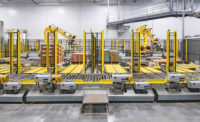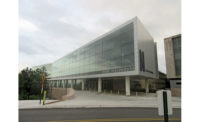Wind Farms, Power Plants Drive Region’s Largest Projects

Mercyhealth is constructing the $485-million Women and Children’s Hospital in Rockford, Ill.
RENDERING COURTESY OF AECOM
The winds of change are blowing through the Midwest, particularly in the power sector. This year’s ENR Midwest Top Starts list—which ranks the largest projects to break ground in 2016—features seven wind farms within the top 25 projects. A total of 10 power projects made this year’s rankings.
Tradewind Energy developed two major wind farms in the region in 2016. The $610-million Cimarron Bend Wind Farm in Minneola, Kan., is its largest to date, generating 400 MW of power with the ability to expand up to 600 MW. The site spans more than 60,000 acres and includes more than 100 landowners, but less than 2% of that land must be taken out of service for turbine foundations, access roads and other related infrastructure.
The main power purchasers from Cimarron are the Kansas City, Kan., Board of Public Utilities and Google.
|
|
Geoff Coventry, chief operating officer with Tradewind Energy, says the project represents its two major customers—utilities and commercial/industrial clients. Utilities continue to be the primary buyers of wind power, and Conventry sees more room for growth. “Utilities continue to move to higher and higher percentages of renewables,” he says. “There’s still a lot of room to run there, so we see that trend continuing.”
The company’s second-largest project in 2016 was the $500-million Rock Creek Wind Project in Atchison County, Mo. Kansas City Power and Light signed a purchase agreement for the 300-MW farm.
Commercial and industrial clients are the next big target, say Coventry. While big data center companies have been early purchasers, others are showing interest as well. “We see it broadening into a whole spectrum of Fortune 500 companies,” he says. “They all basically have the same goal, which is to increase the amount of electricity that comes from renewable energy. They can meet their sustainability goals and provide a hedge against gas prices in the future.”
The challenge with commercial customers is that they typically don’t buy as much power as utilities. “For Cimarron, it was two customers on 400 MW,” he notes. “For some of these [all-commercial] projects, we may need four to six customers to achieve 400 MW.”
Coventry says Tradewind aims to develop roughly 1 GW per year of new projects.
Wendy Davidson, business development director of Wind Energy at Mortenson Construction, says she hears similar outlooks for its customers. Last year, Mortenson built the 300-MW Ida Grove and 250-MW O’Brien Wind Farm projects in Iowa as well as the $435-million Western Plains Wind Farm in Spearville, Kan.
Davidson notes that 2016 saw a strong rise in activity as customers moved to complete projects before tax credits expired. However, those credits have been extended to 2020, and she sees continued growth in the coming years. “Our customers have very aggressive wind energy goals for the next four years,” she says. “From 2017 through 2020, you will see that trend continue and maybe grow in the scale and size of the projects that are being planned.”
In addition to wind farms, natural gas–fired power projects are also moving ahead, including the $900-million Lordstown Energy Center in Lordstown, Ohio. The 940-MW plant is expected to produce enough energy to power about 800,000 homes.
Phase 1 of the 1.4-GW St. Joseph Energy Center is underway in New Carlisle, Ind. The greenfield natural gas-fired, combined-cycle power plant (CCPP) is being built in two phases of approximately 700 MW each.
With so many power projects in the works, transmission line projects are also in high demand. American Transmission Co. and Xcel Energy are building the $580-million Badger-Coulee Transmission Line in Dane County, Wis. The 180-mile, 345-kilovolt line is expected to be in service in 2018.
Within the building sector, residential projects continue to show strength, particularly in major cities. In September, ground was broken on the $1-billion Vista Tower in Chicago. The 95-story, 1,200-ft-tall tower will feature high-end condominiums stacked above a five-star hotel.
Gail Lissner, vice president at Chicago-based consulting firm Appraisal Research Counselors, says the Vista is noteworthy not just because of its height, but because it will deliver 406 condominiums to downtown Chicago. “Since the recession, we’ve seen boutique condo development,” Lissner says. “We have only seen one new development with more than 100 condominiums in downtown Chicago.”
Lissner says that in 2005, Chicago’s condominium market peaked at nearly 8,200 units delivered. Since 2009, the market has stayed below 650 units per year. Meanwhile, the rental market remains strong with approximately 4,000 units expected annually in 2017 and 2018. She notes that the current occupancy rate for rental units is above 92%.
The $400-million One Bennett Park in Chicago will feature a mix of 69 condominiums and 250 rentals. In addition to the tower, designed by Robert A.M. Stern, the project will include a 1.7-acre park designed by Michael Van Valkenburgh Associates.
The $230-million Sinclair apartment tower also broke ground in Chicago last year. The 35-story tower, developed by Fifield Cos., is expected to deliver nearly 400 rental units.
Residential hasn’t fit everyone’s development plans. The $145-million Broadway at Center project in Rochester, Minn., was initially envisioned as a mixed residential and commercial tower but was re-envisioned as a 19-story Hilton hotel with retail and a restaurant.
Omni is developing a hybrid residential and hospitality project with its $289-million Omni Louisville Hotel in Louisville. The 30-story building will feature 612 hotel rooms and 225 high-end apartments.
Health care continues to be a strong market in the Midwest. Major projects include the $485-million Mercyhealth Women and Children’s Hospital in Rockford, Ill., the $350-million ProMedica Toledo Hospital Generations Tower in Toledo and the $175-million University of Michigan Health System Brighton Health Center South in Brighton, Mich.
No Top Starts list would be complete without a signature building, such as the $500-million Wisconsin Entertainment and Sports Center in Milwaukee. The new multipurpose 714,000-sq-ft arena will be home to the Milwaukee Bucks. It will also include an entertainment district on the 30-acre site. The arena is expected to be finished in time for the 2019-20 NBA season.



